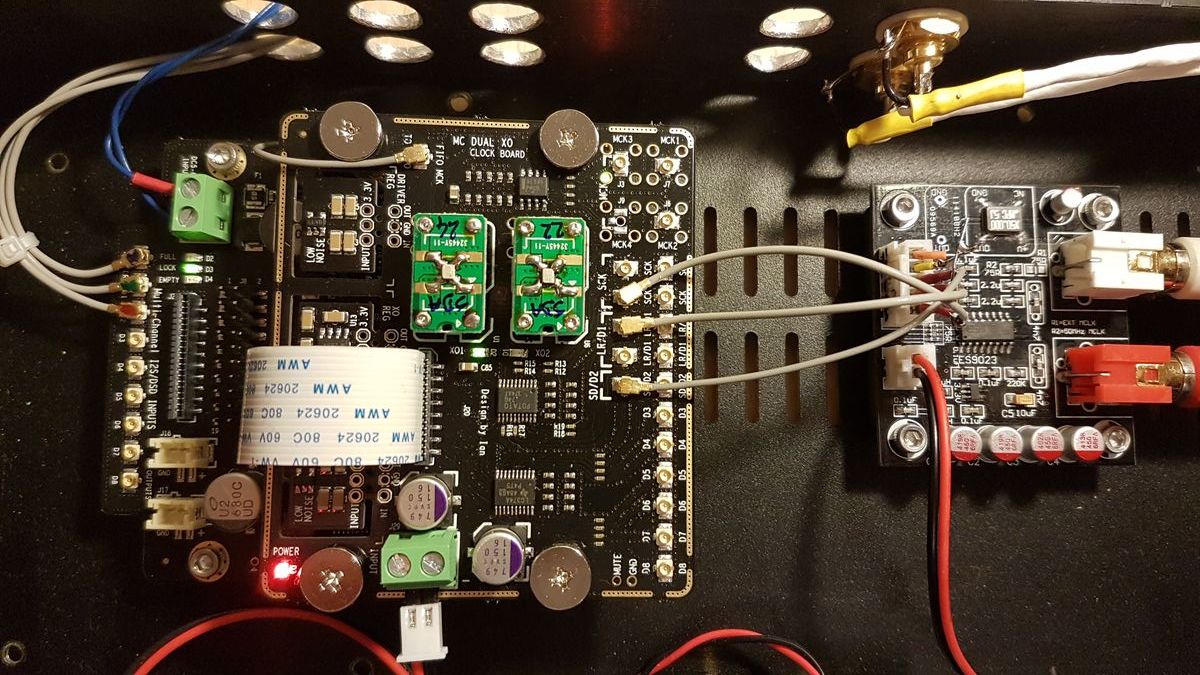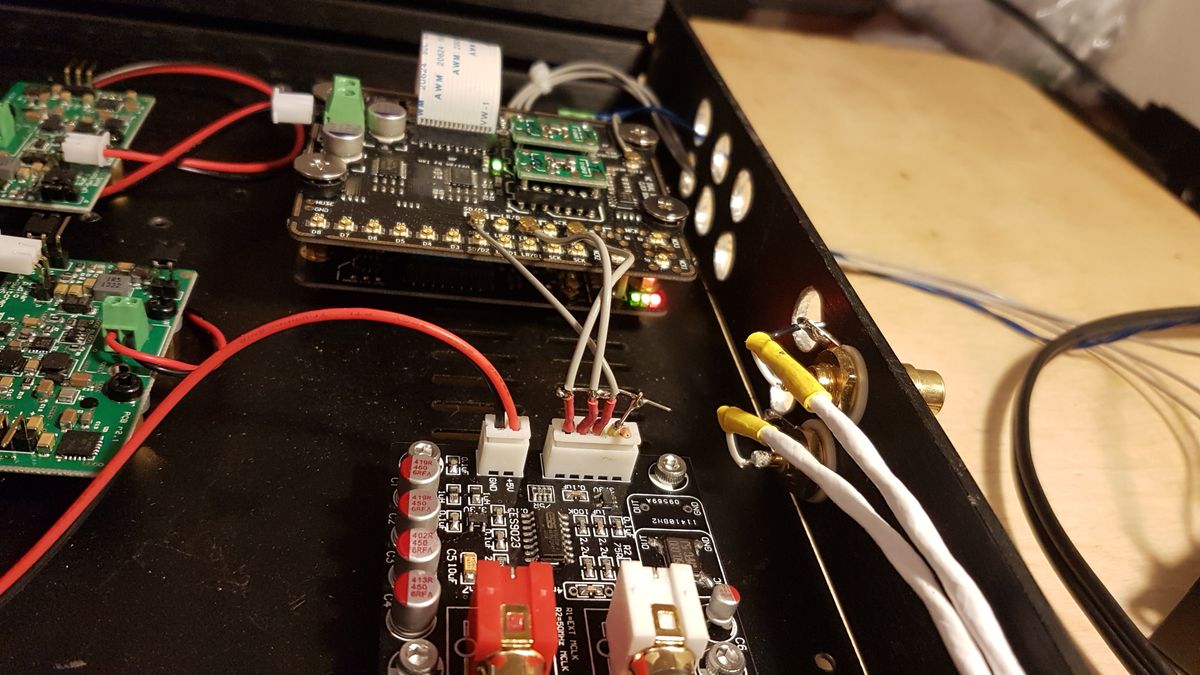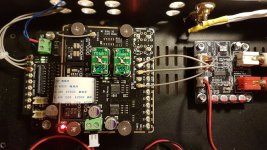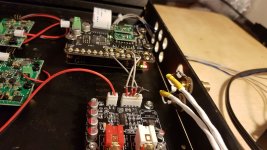Hello,
I am implementing the McFIFO and McDualXO boards and I have a problem with the McDualXO's u. fl I2S outputs.
In fact, I obtain behaviours that are not reproducible.
As I couldn't get the jlsounds AK4490 DAC to work so I supplied a simpler ES9023 DAC without MCLK.
Depending on the LR and SD outputs used, I get:
· No sound
· A sizzling sound
· Correct sound.
But in the vast majority of cases: no sound.
If I turn off a working configuration, when restarting it no longer works.
The contacts are good (point-to-point tests).
Oscillators are good (tested on another configuration with the FIFO II and DualXO boards).
Depending on the frequency of the music played the oscillators tilt well.
The DAC ES9023 is good (used with FIFO II and DualXO cards without problems).
The McFIFO board is powered by the Raspberry Pi 3 Model B.
The McDualXO card is powered by a SilentSwitcher from Jan Didden.
-> the power supply LED is red: is it normal ? (see picture)
The DAC ES9023 is powered by a SilentSwitcher.
I don't understand what the problem is apart from a malfunction in the outputs of the MCDualXO board.


Thank you for your help.
nounouchet
I am implementing the McFIFO and McDualXO boards and I have a problem with the McDualXO's u. fl I2S outputs.
In fact, I obtain behaviours that are not reproducible.
As I couldn't get the jlsounds AK4490 DAC to work so I supplied a simpler ES9023 DAC without MCLK.
Depending on the LR and SD outputs used, I get:
· No sound
· A sizzling sound
· Correct sound.
But in the vast majority of cases: no sound.
If I turn off a working configuration, when restarting it no longer works.
The contacts are good (point-to-point tests).
Oscillators are good (tested on another configuration with the FIFO II and DualXO boards).
Depending on the frequency of the music played the oscillators tilt well.
The DAC ES9023 is good (used with FIFO II and DualXO cards without problems).
The McFIFO board is powered by the Raspberry Pi 3 Model B.
The McDualXO card is powered by a SilentSwitcher from Jan Didden.
-> the power supply LED is red: is it normal ? (see picture)
The DAC ES9023 is powered by a SilentSwitcher.
I don't understand what the problem is apart from a malfunction in the outputs of the MCDualXO board.
Thank you for your help.
nounouchet
Attachments
@nounouchet
If you have a McFIFO controller it will tell you more details.
GitHub - iancanada/McFIFOdisplay: Arduino based McFIFO display
You can just simply make one by an Arduino board and a LCD.
Please let me know.
Regards,
Ian
If you have a McFIFO controller it will tell you more details.
GitHub - iancanada/McFIFOdisplay: Arduino based McFIFO display
You can just simply make one by an Arduino board and a LCD.
Please let me know.
Regards,
Ian
Hi,
Please : anyone aware of a non expensive USB to I2S card which can be slavered by the uf-l MLCK outputt of the Clock II board (no FIFO in between) ?
Anyone aware about the BCLK speed at the output of the clock II board and the BLCK outputt of the PCM board please with a 44.1 Fs playback ?
Please : anyone aware of a non expensive USB to I2S card which can be slavered by the uf-l MLCK outputt of the Clock II board (no FIFO in between) ?
Anyone aware about the BCLK speed at the output of the clock II board and the BLCK outputt of the PCM board please with a 44.1 Fs playback ?
Hi Ian,
1. DC input:
McFIFO: 5V
McDualXO: 5V - Driver Reg: 3.3V - XO Reg: 3.3V - Reclk Reg: 3.3V
2. P3 I2S works with FIFO II and DualXO -
On McFIFO board: When play: Lock led ok, When stop: Empty led ok
On McDualXO: XO1 and XO2 switch well
I have music (rarely) or not only by manipuling u.fl outputs
3. I checked all connections
I have arduino nano and displays, i will try your FifoDisplay arduino code.
nounouchet
1. DC input:
McFIFO: 5V
McDualXO: 5V - Driver Reg: 3.3V - XO Reg: 3.3V - Reclk Reg: 3.3V
2. P3 I2S works with FIFO II and DualXO -
On McFIFO board: When play: Lock led ok, When stop: Empty led ok
On McDualXO: XO1 and XO2 switch well
I have music (rarely) or not only by manipuling u.fl outputs
3. I checked all connections
I have arduino nano and displays, i will try your FifoDisplay arduino code.
nounouchet
Those u.fl cables going to the DAC connector look very suspicious, have you measured the resistance between the signal and ground for each cable? Maybe there is some contact happening there under certain angles so it sometimes works and most times doesn't and FIFO II handles that better.
Some news.
In order to determine where the problem is coming from, I have replaced the FIFO II/isolator/DualXO boards of my current digital preamplifier with McFIFO/McDualXO boards (same cables and power supplies): it works.
I've tried 2 I2S DAC, both work without any problems with their respective u. fl cables et connections.
But if I change the power supply of the McFIFO card: it doesn't work anymore
Current preamp power supplies: FIFO: SMPS CONDOR; DualXO: SALAS reflektor-D mini (even 0V)
Power supplies tested for McFIFO with no success:
- RPI 3 (source)
- SilentSwitcher
with and without common 0V
I put McFIFO and McDualXO back in their case with 1 SilentSwitcher for McFIFO and 1 SilentSwitcher for McDualXO: it works on first startup and then not after restart.
Very strange...
PS: When it doesn't work led are ok on McFIFO (empty, lock) and McDualXO (XO1, XO2)
Ian do you have any idea ?
In order to determine where the problem is coming from, I have replaced the FIFO II/isolator/DualXO boards of my current digital preamplifier with McFIFO/McDualXO boards (same cables and power supplies): it works.
I've tried 2 I2S DAC, both work without any problems with their respective u. fl cables et connections.
But if I change the power supply of the McFIFO card: it doesn't work anymore
Current preamp power supplies: FIFO: SMPS CONDOR; DualXO: SALAS reflektor-D mini (even 0V)
Power supplies tested for McFIFO with no success:
- RPI 3 (source)
- SilentSwitcher
with and without common 0V
I put McFIFO and McDualXO back in their case with 1 SilentSwitcher for McFIFO and 1 SilentSwitcher for McDualXO: it works on first startup and then not after restart.
Very strange...
PS: When it doesn't work led are ok on McFIFO (empty, lock) and McDualXO (XO1, XO2)
Ian do you have any idea ?
Seems like the SilentSwitcher can't provide the necessary voltage/current. How do you power the SilentSwitcher?
Also, if your source is an PRI 3 and you have connected the McFIFO power source to it (via the GPIO header) then the McFIFO will be powering the RPI 3 (even if you have it connected to USB) which requires a lot more than the 500mA the SilentSwitcher can provide.
I suspect that if you power the McFIFO from the RPI 3 it doesn't work because the RPI 3 probably provides less than 5 V under load.
Also, if your source is an PRI 3 and you have connected the McFIFO power source to it (via the GPIO header) then the McFIFO will be powering the RPI 3 (even if you have it connected to USB) which requires a lot more than the 500mA the SilentSwitcher can provide.
I suspect that if you power the McFIFO from the RPI 3 it doesn't work because the RPI 3 probably provides less than 5 V under load.
Hi wealas,
With 5V input, SilentSwitcher deliver 0.5A at 5V output.
I supply with 9V/2A so SilentSwitcher can deliver 1A.
When i supply McFIFO with RPI 3 a use, for my test a 5,1V/2.5A PSU.
I have a 65VA linear PSU with 5V/3.5A output for my listening situation, i can try.
McFIFO need 160 mA, so I have a doubt about the lack of power supply.
But it's an interesting lead
With 5V input, SilentSwitcher deliver 0.5A at 5V output.
I supply with 9V/2A so SilentSwitcher can deliver 1A.
When i supply McFIFO with RPI 3 a use, for my test a 5,1V/2.5A PSU.
I have a 65VA linear PSU with 5V/3.5A output for my listening situation, i can try.
McFIFO need 160 mA, so I have a doubt about the lack of power supply.
But it's an interesting lead
Have you actually measured the output voltages from the various supplies? I won't be surprised if the RPI PSU voltage sags during boot and the McFIFO sees voltage that's too low. Same with the SilentSwitcher.
Hi wealas,
With 5V input, SilentSwitcher deliver 0.5A at 5V output.
I supply with 9V/2A so SilentSwitcher can deliver 1A.
When i supply McFIFO with RPI 3 a use, for my test a 5,1V/2.5A PSU.
I have a 65VA linear PSU with 5V/3.5A output for my listening situation, i can try.
McFIFO need 160 mA, so I have a doubt about the lack of power supply.
But it's an interesting lead
Some news.
In order to determine where the problem is coming from, I have replaced the FIFO II/isolator/DualXO boards of my current digital preamplifier with McFIFO/McDualXO boards (same cables and power supplies): it works.
I've tried 2 I2S DAC, both work without any problems with their respective u. fl cables et connections.
But if I change the power supply of the McFIFO card: it doesn't work anymore
Current preamp power supplies: FIFO: SMPS CONDOR; DualXO: SALAS reflektor-D mini (even 0V)
Power supplies tested for McFIFO with no success:
- RPI 3 (source)
- SilentSwitcher
with and without common 0V
I put McFIFO and McDualXO back in their case with 1 SilentSwitcher for McFIFO and 1 SilentSwitcher for McDualXO: it works on first startup and then not after restart.
Very strange...
PS: When it doesn't work led are ok on McFIFO (empty, lock) and McDualXO (XO1, XO2)
Ian do you have any idea ?
Replace power supplies for McFifo and McDualXO, if it is a work then the problem would the power supply.
Please do some additional check to the common ground of different power supplies to avoid any ground current or wrong ground connections.
Ian
Another possibility could be the cabling. If you use very long cables to the power supply or neglect to twist the wires together, the inductance may be very high causing the di/dt to suffer. This means that the current transients of the load will cause the voltage to sag on the load board. the voltage will look fine at the power supply, but when transient current demands occur, the voltage will sag on the board.
This sag can also occur if the power supply does not have a fast-reacting regulator, or the power decoupling on the board is insufficient. Usually modern switchers are very fast reacting, but there are exceptions.
Steve N.
This sag can also occur if the power supply does not have a fast-reacting regulator, or the power decoupling on the board is insufficient. Usually modern switchers are very fast reacting, but there are exceptions.
Steve N.
I use silentswitchers to avoid having transformers in the case.
I supply the silentswitchers directly in 9v from a PC charger located outside the case.
So it is not easy for me to change power supplies.
Currently I can make McFIFO/McDualXO work 2 times out of 3 at startup.
My cables between the power supplies and the boards are 20 centimetres. I'll try to twist them better and see if I have a difference.
I supply the silentswitchers directly in 9v from a PC charger located outside the case.
So it is not easy for me to change power supplies.
Currently I can make McFIFO/McDualXO work 2 times out of 3 at startup.
My cables between the power supplies and the boards are 20 centimetres. I'll try to twist them better and see if I have a difference.
I use silentswitchers to avoid having transformers in the case.
I supply the silentswitchers directly in 9v from a PC charger located outside the case.
So it is not easy for me to change power supplies.
Currently I can make McFIFO/McDualXO work 2 times out of 3 at startup.
My cables between the power supplies and the boards are 20 centimetres. I'll try to twist them better and see if I have a difference.
20cm is fine. Another thing you can do is solder an electrolytic cap near the end of the cable. Using solid wire for the umbilical cable will help too, 20-22 gauge.
Steve N.
Empirical Audio
Hello I have not the luck to have my two previous questions answered...
I have an other one please, hopng the interest of it is good enough to be answered ! I would like to master the USB to I2S JL Sound board with the MCLK output of the DUAL XO Clock II board ! Then should I have please to feed the dac with the I2S output direct from the JL Sound board or should I send the I2S through the Ian's Clock II board then using the I2S outputs of this last for the Dac !
Even if too simle questions, answer to this questions and the two last here will help a lot.
@ nounouchet : if not yet checked : the uf-l plugs have sometimes to be helped with the finger by moving the head of the uf-l head of the cable on it (open circuit despite it's pluged !)
Many thanks for your help,
I have an other one please, hopng the interest of it is good enough to be answered ! I would like to master the USB to I2S JL Sound board with the MCLK output of the DUAL XO Clock II board ! Then should I have please to feed the dac with the I2S output direct from the JL Sound board or should I send the I2S through the Ian's Clock II board then using the I2S outputs of this last for the Dac !
Even if too simle questions, answer to this questions and the two last here will help a lot.
@ nounouchet : if not yet checked : the uf-l plugs have sometimes to be helped with the finger by moving the head of the uf-l head of the cable on it (open circuit despite it's pluged !)
Many thanks for your help,
Last edited:
Hello I have not the luck to have my two previous questions answered...
I have an other one please, hopng the interest of it is good enough to be answered ! I would like to master the USB to I2S JL Sound board with the MCLK output of the DUAL XO Clock II board ! Then should I have please to feed the dac with the I2S output direct from the JL Sound board or should I send the I2S through the Ian's Clock II board then using the I2S outputs of this last for the Dac !
Even if too simle questions, answer to this questions and the two last here will help a lot.
@ nounouchet : if not yet checked : the uf-l plugs have sometimes to be helped with the finger by moving the head of the uf-l head of the cable on it (open circuit despite it's pluged !)
Many thanks for your help,
This is advanced application. I think McFIFO/McDualXO have this feature. Please see user's manual for details.
Regards,
Ian
I have a clock II spare but no FIFO for this one, reason of the question, have many of your gears Ian !
The clock II manual say nothing about my question, it basicly just describe how to connect a fifo II to a clock II ! Does the clock II only work with FIFO, why two boards so ? I would like the manual says if the clock II can accept an I2S without FIFO if the clock II is slavering this previous device (why not as its an asynchronous USB and there is only one clock fomain if it is slavered by the clock II ?!)
The USB to I2S I talk about can be slaved by cutting a strap and have a pin to MCLK injection (no more xtal are working on it), but just want to know if clock II needs to see the I2S of this board for slavering it or not !
So you just say, look at the manual, i.e. buy a FIFO II ! Just think I deserve not that type of answers. Just need a little tip, no long debugging ! And my two last questions about the speed of the Blck is not Advanced use just a basic I don't understand and your simple answers would help !
The clock II manual say nothing about my question, it basicly just describe how to connect a fifo II to a clock II ! Does the clock II only work with FIFO, why two boards so ? I would like the manual says if the clock II can accept an I2S without FIFO if the clock II is slavering this previous device (why not as its an asynchronous USB and there is only one clock fomain if it is slavered by the clock II ?!)
The USB to I2S I talk about can be slaved by cutting a strap and have a pin to MCLK injection (no more xtal are working on it), but just want to know if clock II needs to see the I2S of this board for slavering it or not !
So you just say, look at the manual, i.e. buy a FIFO II ! Just think I deserve not that type of answers. Just need a little tip, no long debugging ! And my two last questions about the speed of the Blck is not Advanced use just a basic I don't understand and your simple answers would help !
I have a clock II spare but no FIFO for this one, reason of the question, have many of your gears Ian !
The clock II manual say nothing about my question, it basicly just describe how to connect a fifo II to a clock II ! Does the clock II only work with FIFO, why two boards so ? I would like the manual says if the clock II can accept an I2S without FIFO if the clock II is slavering this previous device (why not as its an asynchronous USB and there is only one clock fomain if it is slavered by the clock II ?!)
The USB to I2S I talk about can be slaved by cutting a strap and have a pin to MCLK injection (no more xtal are working on it), but just want to know if clock II needs to see the I2S of this board for slavering it or not !
So you just say, look at the manual, i.e. buy a FIFO II ! Just think I deserve not that type of answers. Just need a little tip, no long debugging ! And my two last questions about the speed of the Blck is not Advanced use just a basic I don't understand and your simple answers would help !
Dual XO II has a controller on board. It talks with FIFO II over SPI bus. If you want to use it as clock board for your USB streamer, you need to disable (I don't know how
Regards,
Ian
- Home
- Source & Line
- Digital Line Level
- Asynchronous I2S FIFO project, an ultimate weapon to fight the jitter

